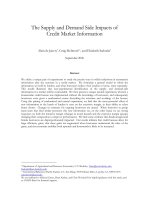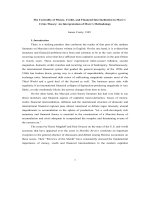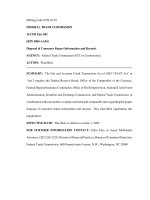The Gramm-Leach-Bliley Act Privacy of Consumer Financial Information pptx
Bạn đang xem bản rút gọn của tài liệu. Xem và tải ngay bản đầy đủ của tài liệu tại đây (40.93 KB, 14 trang )
FEDERAL TRADE COMMISSION
BUREAU OF CONSUMER PROTECTION
DIVISION OF FINANCIAL PRACTICES
The Gramm-Leach-Bliley Act
Privacy of Consumer Financial Information
Subtitle A of Title V of the Gramm-Leach-Bliley Act (“GLB Act”) has privacy provisions
relating to consumers’ financial information. Under these provisions, financial
institutions have restrictions on when they may disclose a consumer’s personal financial
information to nonaffiliated third parties. Financial institutions are required to provide
notices to their customers about their information-collection and information-sharing
practices. Consumers may decide to “opt out” if they do not want their information
shared with nonaffiliated third parties. The GLB Act provides specific exceptions under
which a financial institution may share customer information with a third party and the
consumer may not opt out. All financial institutions are required to provide consumers
with a notice and opt-out opportunity before they may disclose information to
nonaffiliated third parties outside of what is permitted under the exceptions.
Subtitle A of Title V of the GLB Act and the Federal Trade Commission regulation can
be found on the Gramm-Leach-Bliley Act web page which can be reached directly from
the FTC home page at www.ftc.gov.
I.
Important Dates and Citations about the Gramm-Leach-Bliley Act
Statute (Public Law 106-102, 15 U.S.C. § 6801, et seq.)
•
enacted November 12, 1999
Regulations (16 C.F.R. § 313, 65 Fed. Reg. 33646 (May 24, 2000))
•
effective date: November 13, 2000
•
compliance date: July 1, 2001
•
Other Agencies’ Rules
•
Federal Reserve Board:
12 C.F.R. § 216
•
OTS:
12 C.F.R. § 573
•
OCC:
12 C.F.R. § 40
•
FDIC:
12 C.F.R. § 332
•
NCUA:
12 C.F.R. § 716
•
SEC:
17 C.F.R. § 248
•
CFTC:
17 C.F.R. § 160
* The views expressed in this presentation are not the official views of the Federal Trade Commission
or of any individual Commissioner. June 18, 2001.
-2-
II. Overview
A.
Key Definitions
•
Financial Institution
•
Consumers and Customers
• Nonpublic Personal Information
B.
Notices
C.
Exceptions
D.
Limits on Reuse and Redisclosure
III. Financial Institution
Definition: Any institution the business of which is engaging in financial activities as
described in section 4(k) of the Bank Holding Company Act (12 U.S.C. § 1843(k)).
Under the Final Rule promulgated by the Federal Trade Commission (FTC), an
institution must be significantly engaged in financial activities to be considered a
“financial institution.”
A.
Financial Activities:
•
Lending, exchanging, transferring, investing for others, or safeguarding
money or securities; insuring, guaranteeing, or indemnifying against loss,
harm, damage, illness, disability, or death; providing financial investment
or economic advisory services; underwriting or dealing with securities.
[§ 4(k)(4)(A-E)]
•
Engaging in an activity that the Federal Reserve Board has determined to
be closely related to banking. [§ 4(k)(4)(F); 12 C.F.R. § 225.28]. For
example:
•
Extending credit and servicing loans
• Collection agency services
•
Real estate and personal property appraising
•
Check guaranty services
•
Credit bureau services
•
Real estate settlement services
•
Leasing real or personal property (on a nonoperating basis for an
initial lease term of at least 90 days)
•
Engaging in an activity that a bank holding company may engage in
outside of the United States. [§ 4(k)(4)(G); 12 C.F.R. § 211.5(d)]. For
example:
•
Operating a travel agency in connection with financial services
-3-
1
Even if a business engages in one of these financial activities, it does not necessarily have to
provide privacy notices. The notice obligations depend on whether the business is providing a financial
product or service to customers or, if they share the information with nonaffiliated third parties outside of
specific exceptions, to consumers.
•
Only those activities determined to be financial activities under § 4(k)(1-
3) as of November 12, 1999, are covered by the FTC Privacy Rule. While
the Federal Reserve Board and the Department of Treasury have authority
to add activities that are “incidental” or “complementary” to financial
activities, the FTC will review those determinations before proposing to
extend coverage of its Rule to such new activities.
B.
Examples of businesses that engage in “financial activities” and are “financial
institutions” for purposes of the GLB Act
1
:
•
Mortgage lender or broker
•
Check casher
•
Pay-day lender
•
Credit counseling service and other financial advisors
•
Medical-services provider that establishes for a significant number of its
patients long-term payment plans that involve interest charges
•
Financial or investment advisory services including tax planning, tax
preparation, and instruction on individual financial management
•
Retailer that issues its own credit card
•
Auto dealers that lease and/or finance
• Collection agency services
•
Relocation service that assists individuals with financing for moving
expenses and/or mortgages
•
Sale of money orders, savings bonds, or traveler’s checks
•
Government entities that provide financial products such as student loans
or mortgages
C.
“Significantly Engaged” in Financial Activities:
•
Whether a financial institution is “significantly engaged” in financial
activities is a flexible standard that takes into account all the facts and
circumstances.
•
Examples of businesses that are not “significantly engaged” for purposes
of the GLB Act:
•
Retailer that does not issue its own credit card (even if it accepts
other credit cards)
•
Grocery store that allows consumers to get cash back by writing a
check in an amount higher than the actual purchase price
-4-
•
Merchant who allows an individual to “run a tab”
•
Retailer that provides occasional “lay-away” and deferred payment
plans or accepting payment by means of credit cars issued by
others as its only means of extending credit
IV. Consumers and Customers
A.
Consumers
Definition: A “consumer” is an individual who obtains or has obtained a financial
product or service from a financial institution that is to be used primarily for
personal, family, or household purposes, or that individual’s legal representative.
Examples of Consumer Relationships:
•
Applying for a loan
•
Obtaining cash from a foreign ATM, even if it occurs on a regular basis
•
Cashing a check with a check-cashing company
•
Arranging for a wire transfer
General Obligations to Consumers:
•
Provide an initial (or “short-form”) notice about the availability of the
privacy policy if the financial institution shares information outside the
permitted exceptions.
•
Provide an opt-out notice, with the initial notice or separately, prior to a
financial institution sharing nonpublic personal information with
nonaffiliated third parties.
•
Provide consumers with a “reasonable opportunity” to opt out before
disclosing nonpublic personal information about them to nonaffiliated
third parties, such as 30 days from the date the notice is mailed.
•
If a consumer elects to opt out of all or certain disclosures, a
financial institution must honor that opt-out direction as soon as is
reasonably practicable
after the opt-out is received.
•
If you change your privacy practices such that the most recent privacy
notice you provided to a consumer is no longer accurate (e.g., you
disclose a new category of NPI to a new nonaffiliated third party outside
of specific exceptions and those changes are not adequately described in
your prior notice), you must provide new revised privacy and opt-out
notices.
B.
Customers
Definition: A “customer” is a consumer who has a “customer relationship” with a
financial institution. A “customer relationship” is a continuing relationship with
a consumer.
Examples of Establishing a Customer Relationship:
-5-
•
Opening a credit card account with a financial institution
•
Entering into an automobile lease (on a non-operating basis for an initial
lease term of at least 90 days) with an automobile dealer
•
Providing personally identifiable financial information to a broker in order
to obtain a mortgage loan
• Obtaining a loan from a mortgage lender
•
Agreeing to obtain tax preparation or credit counseling services
“Special Rule” for Loans: The customer relationship travels with ownership of
the servicing rights.
•
A financial institution establishes a customer relationship with a
consumer when it originates a loan.
•
If it subsequently sells the loan and retains the servicing rights, it
continues to have a customer relationship with the consumers.
•
If it subsequently transfers the servicing rights, the entity that
acquires servicing has a customer relationship with the consumer.
•
Those with an ownership interest in the loan but without servicing
rights have consumers.
General Obligations to Customers
•
Provide an initial privacy notice not later than when the customer
relationship is established.
•
Provide, with the initial privacy notice or separately, an opt-out notice
prior to sharing nonpublic personal information with nonaffiliated third
parties outside of specific exceptions.
•
Provide an annual privacy notice annually for the duration of the customer
relationship.
•
Provide customers with a “reasonable opportunity” to opt out before
disclosing nonpublic personal information about them to nonaffiliated
third parties, such as 30 days from the date the notice is mailed.
•
NOTE: If a customer elects to opt out of all or certain disclosures,
a financial institution must honor that opt-out direction as soon as
reasonably practicable after the opt-out is received.
•
If you change your privacy practices such that the most recent privacy
notice you provided to a consumer is no longer accurate (e.g., you
disclose a new category of NPI or to a new nonaffiliated third party
outside of specific exceptions and those changes are not adequately
described in your prior notice), you must provide new revised privacy and
opt-out notices.
V.
Nonpublic Personal Information (“NPI”)
NPI Includes:
•
Nonpublic personally identifiable financial information; and
-6-
•
Any list, description, or other grouping of consumers (and publicly
available information pertaining to them) derived using any personally
identifiable financial information that is not publicly available.
NPI Excludes:
• Publicly available information; and
•
Any list, description or other grouping of consumers (including publicly
available information pertaining to them) that is derived without using
personally identifiable financial information that is not publicly available.
“Personally Identifiable Financial Information” is any information:
•
A consumer provides to obtain a financial product or service;
•
About a consumer resulting from any transaction involving a financial
product or service; or
•
Otherwise obtained about a consumer in connection with providing a
financial product or service.
“Publicly Available Information” is:
•
Any information that a financial institution has a reasonable basis to
believe is lawfully made available to the general public from:
•
Federal, State, or local government records;
• Widely distributed media; or
•
Disclosures to the general public required by Federal, State, or
local law.
“Reasonable Basis to Believe” means the financial institution:
•
Cannot assume information is publicly available.
•
Must take steps to determine if:
•
the information is of the type generally made available to
the public;
•
whether an individual can direct that it not be made
available; and
• if so, whether that particular consumer has directed that it
not be disclosed.
Examples of Publicly Available Information:
•
Fact that an individual is a mortgage customer of a particular
financial institution where that fact is recorded in public real estate
records
•
Telephone number listed in the phone book
•
Information lawfully available to the general public on a website
(including a website that requires a password or fee for access)
Examples of NPI (assuming such information is not publicly available):
-7-
•
Fact that an individual is the customer of a particular financial institution
•
Consumer’s name, address, social security number, account number
•
Any information a consumer provides on an application
•
Information from a “cookie” obtained in using a website
•
Information on a consumer report obtained by a financial institution
(NOTE: Such information may also be covered by the Fair Credit
Reporting Act)
NPI and Lists: Always consider how the list is derived.
•
List of a finance company’s mortgage customers with their outstanding
mortgage balance and account numbers is NPI
•
List of a retailer’s credit card customers is NPI
•
List of a retailer’s credit card customers that is combined with a list of
magazine subscribers is NPI
•
List of all individuals who purchased washing machines from a retailer is
NOT NPI where the information is not derived from information obtained
in providing a financial product or service
VI. Notices
A.
Types of Notices:
1. Initial: To customers not later than when relationship is established
To consumers prior to sharing nonpublic personal information
2. Opt-Out: To consumers and customers prior to sharing information
3. Short-Form: To consumers who are not customers, in lieu of full initial
notice, prior to sharing nonpublic personal information about them
4. Simplified: To customers if don’t share NPI about current or former
customers with affiliates or nonaffiliated third parties outside exceptions
313.14 and 313.15
5. Annual: To customers for duration of the relationship
6. Revised: To consumers, customers, and former customers
B. Format of Notices: Notices Must Be “Clear and Conspicuous”
1.
“Clear and conspicuous” means that a notice must be reasonably
understandable and designed to call attention to the nature and
significance of the information in the notice.
2.
“Reasonably understandable” means clear and concise sentences, plain
language, active voice.
-8-
3.
“Designed to call attention” means using headings, easily read typeface
and type size, wide margins. On website: use text or visual cues to
encourage scrolling down the page to view the entire notice; place notice
on a frequently accessed page or via a clearly labeled link; ensure that
there are no distracting graphics or sound.
C. Content of Initial and Annual Notices:
[for purposes of this section, “consumers” includes “customers”]
1.
Categories of nonpublic personal information that the financial institution
collects, for example:
• information obtained from the consumer
•
information obtained from the consumer’s transactions with a
financial institution or its affiliate
•
information obtained from nonaffiliated third parties about the
consumer’s transactions with them
• information obtained from a consumer reporting agency
2.
Categories of nonpublic personal information that the financial institution
discloses. Must provide illustrative examples, such as:
•
information from the consumer on applications or other forms,
such as name, address, and social security number
•
information from transactions with the consumer: account number
and balances, payment history, parties to transactions, credit card
usage
•
information from a consumer reporting agency: creditworthiness
and credit history
3.
Categories of affiliates and nonaffiliated third parties to whom the
financial institution discloses nonpublic personal information. Must
provide illustrative examples, such as:
•
Financial service providers, such as mortgage brokers and
insurance companies
•
Non-financial companies, such as magazine publishers, retailers,
and direct marketers
•
Others, such as nonprofit organizations
4.
If the financial institution discloses nonpublic personal information about
former customers:
•
Categories of nonpublic personal information disclosed; and
•
Categories of affiliates and nonaffiliated third parties to whom
nonpublic personal information is disclosed (other than what is
permitted under exceptions 313.14 and 313.15).
-9-
5.
If the financial institution discloses nonpublic personal information to a
nonaffiliated third-party under exception 313.13 (for service providers and
joint marketing partners):
•
Separate statement of the categories of nonpublic personal
information disclosed (including illustrative examples); and
• Statement about whether the third party is:
•
a service provider that performs marketing services on
behalf of the financial institution itself or on behalf of
products or services jointly marketed between two financial
institutions; or
•
another financial institution with whom the financial
institution has entered into a joint marketing agreement.
6.
An explanation of the consumer’s right to opt out.
7.
Any disclosures that the financial institution is required to make under the
Fair Credit Reporting Act.
8.
The financial institution’s policies and practices with respect to protecting
the confidentiality and security of nonpublic personal information.
9. If the financial institution discloses nonpublic personal information to a
nonaffiliated third party under exceptions 313.14 and 313.15, state that
disclosures to nonaffiliated third parties are made as permitted by law.
10.
The financial institution may also reserve the right to disclose categories
of nonpublic personal information that it does not currently disclose or
categories of nonaffiliated third parties to which it does not currently
disclose nonpublic personal information.
D.
Content of Opt-out Notice
[for purposes of this section, “consumers” includes “customers”]
1.
Fact that the financial institution discloses (or reserves the right to
disclose) nonpublic personal information about a consumer to
nonaffiliated third parties.
2.
The consumer’s right to opt out of those disclosures.
3.
A description of a “reasonable means” by which the consumer can opt out,
for example:
•
Toll-free telephone number
•
Detachable form with mailing information
•
If the consumer has agreed to receive notices electronically, an
electronic means such as a form that can be sent via e-mail or
through the financial institution’s website
-10-
•
NOTE: It is NOT a reasonable means to require a consumer to
write her own letter as the ONLY option
Remember: A financial institution must allow a “reasonable opportunity” for the
consumer to opt out before sharing information.
E.
Content of the Short-Form Notice
1.
State that the financial institution’s full privacy policy is available on
request.
2.
Explain a reasonable means by which the consumer may obtain the full
notice, for example:
•
Toll-free telephone number
•
On-site for in-person transactions
F.
Content of Simplified Notice
1.
List the categories of NPI collected.
2.
Provide statement explaining that the institution does not share NPI with
affiliates and nonaffiliated third parties, except as permitted by law (if
applicable).
3.
Provide statement explaining the institution’s polices and practices with
respect to safeguarding NPI.
G.
Revised Notice
If a financial institution changes its policies and practices regarding disclosure of
nonpublic personal information to nonaffiliated third parties outside of specific
exceptions, it must:
•
Provide a new notice that accurately reflects its policies; and
•
Provide a new opt-out notice and a reasonable means to opt out.
H.
Timing of Annual Notice
•
Financial institution must provide an accurate privacy policy to its
customers at least annually during the continuation of the customer
relationship.
•
Annually means at least once in a period of twelve consecutive months
which the financial institution can define but must apply consistently. A
financial institution can send annual notices to all its customers at the
same time each year.
•
Customer opens account in January of 2004. Financial institution
must send its first annual notice to that customer by December
2005.
I.
Delivery of Notices
-11-
•
Consumer or customer must be reasonably expected to receive actual
notice in writing or, if the customer agrees, electronically. Examples of
appropriate delivery include:
•
Hand delivery
•
Mail to last known address
• For a consumer using an ATM, post the notice on the screen and
require acknowledgment of receipt of the notice as a necessary part
of the transaction.
•
For the consumer who conducts transactions electronically, post
the notice on the website and require acknowledgment of receipt
of the notice as a necessary part of the transaction.
•
For the customer who uses a website for electronic financial
transactions and agrees to receive an annual notice at that website,
post the current privacy notice continuously in a clear and
conspicuous manner on that website.
•
The notice CANNOT just be posted in a branch or on a website.
•
Customers must be provided notice in a form that can be retained or
accessed at a later time.
VII.
Exceptions
A financial institution may disclose nonpublic personal information to nonaffiliated third
parties under several exceptions where consumers and customers do not have the right to
opt out of such sharing and, in some cases, will get no notice of the disclosure.
A.
Exception to Opt-Out Requirements: Section 313.13
•
Financial institution must provide notice but not the right to opt out when
it provides nonpublic personal information to:
•
Third party service provider that provides services for the financial
institution; or
•
Other financial institution(s) with whom the financial institution
has entered into a joint marketing agreement.
•
Third party service provider may market the financial institution’s own
products and services or the financial products or services offered under a
“joint marketing agreement” between the financial institution and one or
more other financial institutions.
•
Joint marketing agreement with other financial institution(s) means a
written contract pursuant to which those institutions jointly offer, endorse,
or sponsor a financial product or service.
•
To take advantage of this exception the financial institution must:
• Provide the initial notice as required to consumers and customers;
-12-
and
•
Enter into a contract with the third party service provider or
financial institution under a joint marketing agreement that
prohibits the disclosure or use of the information other than for the
purpose for which it was disclosed.
B.
Exceptions to Notice and Opt-Out Requirements: Sections 313.14 and 313.15
Exception 313.14:
•
Disclosures necessary to effect, administer, or enforce a transaction that a
consumer requests or authorizes (see section 313.14(b)); or
•
Disclosures made in connection with:
•
Servicing or processing a financial product or service that a
consumer requests or authorizes
•
Maintaining or servicing a consumer’s account
•
A proposed or actual securitization, secondary market sale
(including the sale of servicing rights) or similar transactions
Exception 313.15:
•
With consumer consent
•
To protect the confidentiality or security of records
• To protect against or prevent actual or potential fraud
•
For required institutional risk control or for resolving consumer disputes
or inquires
•
To persons holding a legal or beneficial interest relating to the consumer
•
To persons acting in a fiduciary or representative capacity on behalf of the
consumer (i.e., the consumer’s attorney)
•
To provide information to insurance rate advisory organizations, persons
assessing compliance with industry standards, the financial institution’s
attorneys, accountants or auditors
•
To law enforcement entities or self-regulatory groups (to the extent
permitted or required by law)
• To comply with Federal, State, or local laws
•
To comply with subpoena or other judicial process
•
To respond to summons or other requests from authorized government
authorities
•
Pursuant to the Fair Credit Reporting Act, to a consumer reporting agency
or from a consumer report reported by consumer reporting agency
•
In connection with a proposed or actual sale, merger, transfer or exchange
of all or a portion of a business or operating unit
VIII. Limits on Reuse and Redisclosure by a Third Party
These restrictions apply to a third party that receives nonpublic personal information
from a nonaffiliated financial institution.
-13-
A.
Reuse and Redisclosure Under Exception 313.13: Information received under
section 313.13 is restricted by the confidentiality agreement required under that
section and cannot be used except for the purpose for which it was disclosed.
B.
Reuse and Redisclosure Under Exceptions 313.14 and 313.15:
When a third party receives nonpublic personal information from a nonaffiliated
financial institution under exception 313.14 or 313.15, the third party may:
•
Disclose the information to affiliates of the financial institution from
whom it received the information; or
•
Disclose the information to its own affiliates who are limited in their use
and disclosure of the information to the same extent as the third party; or
•
Disclose and use the information pursuant to exceptions 313.14 or 313.15
in the ordinary course of business to carry out the activity covered by the
exception for which it was received.
C.
Reuse and Redisclosure Outside of Exceptions 313.14 and 313.15:
Where a third party receives nonpublic personal information from a financial
institution outside of an exception (after the financial institution has provided
notice and opt out and the consumer has not opted-out), the third party may:
•
Disclose the information to the affiliates of the financial institution from
whom it received the information; or
• Disclose the information to its own affiliates, who are limited in their use
of information in the same manner as the third party; or
•
Disclose the information to any other entity consistent with the privacy
policy of the financial institution from which it received the information.
D.
Examples of Limits on Reuse and Redisclosure:
A third party receives information from a financial institution to process account
transactions authorized by consumers (pursuant to a section 313.14 exception):
•
That third party may disclose that information to other nonaffiliated third
parties in the ordinary course of business to carry out the servicing.
•
It may also disclose it in response to a properly authorized subpoena.
•
It may not use the information for its own marketing or sell it to another
entity for marketing.
A magazine publisher purchases a list of a financial institution’s customers (those
who have not opted-out) where the disclosure falls outside the exceptions:
•
It may use that list for its own purposes.
•
It may disclose that list to other nonaffiliated third parties consistent with
the financial institution’s privacy policy.
IX.
Other Issues
A.
Prohibition on Sharing Account Numbers for Marketing Purposes
-14-
Financial institutions may not disclose, directly or through an affiliate, an account
number of a consumer’s credit card account, bank account, or transaction account
to a nonaffiliated third party for use in marketing. A transaction account is an
account to which a third party can initiate charges.
Exceptions:
•
Disclosure to a consumer reporting agency.
•
Disclosure to an agent or service provider to perform marketing of the
financial institution’s own products or services, provided that the agent or
service provider is not authorized to directly initiate charges to the
account.
•
Disclosure to a participant in a private label credit card program or an
affinity program where the participants are identified to the customer
when the customer enters into the program.
•
Disclosure of an encrypted account number to a nonaffiliated third party,
provided that the financial institution does not give the third party the
means to decode the number or code.
B.
Effect on the Fair Credit Reporting Act
The FCRA is expressly not modified, limited, or superseded by Subtitle A of
Title V of the GLB Act.
C.
Relationship to State Laws:
State laws are not preempted except to the extent that they are “inconsistent” with
this federal law. A state law is not “inconsistent” if it affords “greater protection”
to consumers than provided for by this federal law, as determined by the FTC.









